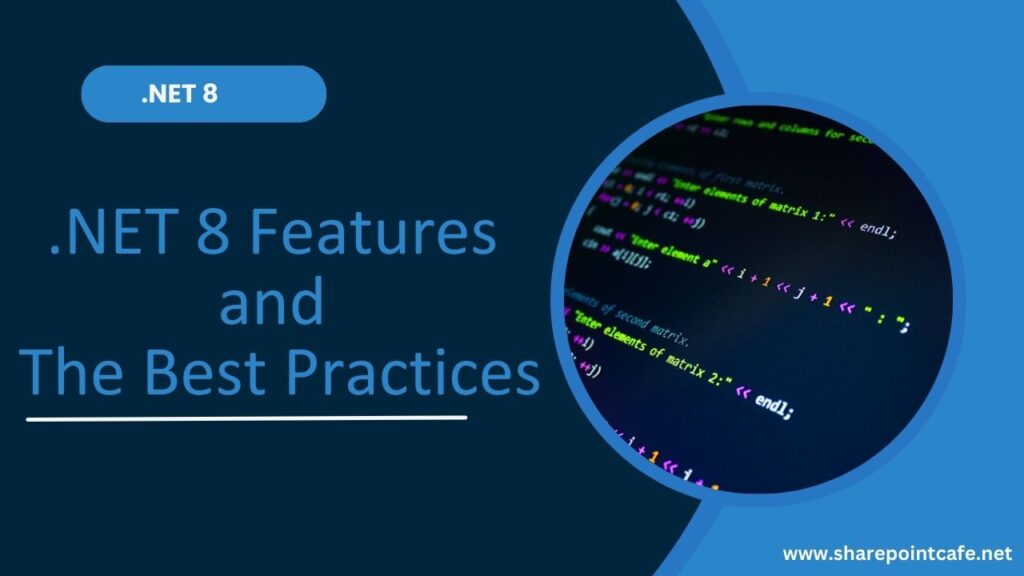In this article, we are going to cover about .NET 8 features and will also see the best practices for building high-performance applications.

You may like this article: Data Validation and Annotation in .NET MVC.NET 8 Overview
.NET 8 is the successor to .NET 7. Microsoft released this version of .NET in November 2023. Microsoft announces 3 years of long-term support (LTS) of .NET 8.
.NET 8 New Features
Performance Enhancements
The .NET 8 runtime has been optimized for improved performance and reduced resource consumption.
Improved Asynchronous Programming
New language features and runtime improvements make it easier to write asynchronous code and take advantage of multi-core systems.
Enhanced Web Development
New features for ASP.NET Core simplify web application development and provide enhanced security and performance.
Modern UI Development
New features in .NET MAUI and Blazor make it easier to build modern, cross-platform user interfaces.
JSON Serialization
.NET 8 offers a System.Text.Json namespace to serialize JSON data. This namespace is a high-performance .NET library that we can use to serialize and deserialize the JSON data.
Improve Dispose Resources
.NET 8 provides IAsyncDisposable interface to support resource cleanup asynchronously. It is similar to the traditional IDisposable interface, but the main difference is that IAsyncDisposable allows the operations asynchronously.
Enhance Data Validation Attributes
In .NET version 8, new properties are available for existing attributes such as RequiredAttribute and RangeAttribute.
API Authoring with .http file
.NET 8 provides .HTTP file with .NET Web API project template. This file helps developers use the HTTP editor in Visual Studio to hit the endpoint directly. This feature allows us to validate, test and refine the APIs quickly and effectively.
Best Practices for High Performance in .NET 8
Just-in-Time (JIT) Compiler Optimizations
The JIT compiler in .NET 8 has been significantly enhanced, resulting in faster code execution.
Reduced Memory Overhead
The garbage collector has been optimized to reduce memory usage and improve overall performance.
Improved Asynchronous Operations
The asynchronous programming model has been enhanced to improve the performance of I/O-bound operations.
.NET 8 Best Practices
Now let’s focus on the the best practices that we need to follow:
Code Optimization
Use .NET analyzers and profilers to identify performance bottlenecks and optimize your code.
Asynchronous Programming
Utilize async/await keywords to improve performance for I/O-bound operations and prevent blocking threads.
Memory Management
Avoid unnecessary memory allocations and manage object lifetimes effectively to optimize memory usage.
Building High-Performance Applications in .NET 8
Choose the Right Data Structures
Select data structures that are optimized for the specific use case.
Optimize Algorithms
Use efficient algorithms to improve performance and reduce resource consumption.
Implement Caching Strategies
Cache frequently accessed data to reduce database calls and improve responsiveness.
Utilize Asynchronous Operations
Implement asynchronous operations to prevent blocking threads and improve overall performance.
Optimizing Memory Usage in .NET 8
| Use value types when possible | Value types are stored directly on the stack, reducing memory allocation overhead. |
| Dispose of unmanaged resources | Release unmanaged resources explicitly to prevent memory leaks. |
| Use memory profiling tools | Identify memory leaks and areas for optimization. |
Leveraging Asynchronous Programming in .NET 8
Improved Responsiveness
Asynchronous operations prevent blocking the main thread, resulting in a more responsive application.
Enhanced Concurrency
Asynchronous operations enable multiple tasks to run concurrently, improving performance and efficiency.
Optimized I/O Operations
Asynchronous I/O operations improve performance by reducing the impact of network latency.
Deploying .NET 8 Applications
Containerization
Deploy .NET 8 applications in containers for consistent environments and simplified deployment.
Cloud Services
Leverage cloud platforms like Azure, AWS, or Google Cloud for scalable and reliable deployment.
CI/CD Pipelines
Automate the build, test, and deployment process using CI/CD pipelines for faster and more efficient releases.
Conclusion
So, in this way, we covered about .NET 8 features and also saw the best practices for building high-performance applications.
Keep Following: SharePointCafe.NET
